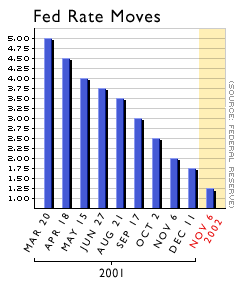NEW YORK (CNN/Money) -
The Federal Reserve left a key short-term interest rate unchanged Wednesday and clung to its view that the risks to the U.S. economy were balanced between weakness and inflation.
The central bank's policy-makers, at the end of a two-day policy meeting, unanimously agreed to leave their target for the federal funds rate, an overnight bank lending rate, unchanged at 1.25 percent, the lowest level since 1961.
The Fed also left the largely symbolic discount rate unchanged at 2.25 percent. In the closely watched statement accompanying its decision, the Fed again offered its "balanced" assessment of the economy.

Though most economists think a Fed rate cut is unlikely this year, a small number worry that underlying weakness in the economy could force the central bank's policy-makers to move at their next meeting March 18.
In its statement Wednesday, the Fed said its low-interest-rate policy was setting the stage for future economic growth, but concerns about the possibility of a U.S. war in Iraq were keeping the economy in neutral for the moment.
"Oil price premiums and other aspects of geopolitical risks have reportedly fostered continued restraint on spending and hiring by businesses," the statement from the central bank said. "However, the [policy makers believe] that as those risks lift, as most analysts expect, the accommodative stance of monetary policy, coupled with ongoing growth in productivity, will provide support to an improving economic climate over time."
The Fed's decision, which was widely expected by Wall Street and economists, had little impact on U.S. stock prices, which were mixed in afternoon trade. Treasury bond prices fell.
With the fed funds rate so close to zero, many economists think the central bankers want to delay making any more cuts until they seem absolutely necessary. Though there have been recent signs of weakness in the economy, there have also been some signs of improvement.
Fed officials have often stated they think the economy's biggest problem is uncertainty about the possibility of a U.S. war in Iraq -- uncertainty they hope will clear up soon, leading to a sudden upturn in economic activity.
"If that's the way the world is, then that's fantastic, because if oil prices go down and the Iraq situation disappears, we're off to the races again," said Lara Rhame, a former Fed economist, now with Brown Brothers Harriman. "But I think that opinion is at worst naive and at best simply putting on a brave face."
While the Fed hopes businesses are delaying spending and hiring plans until the Iraq situation passes, Rhame said, businesses could also be stalling simply because they've got a glut of excess production capacity after an orgy of spending in the late 1990s.
If the Iraq situation clears up, but economic activity doesn't pick up as a result, Rhame said, the Fed could be cutting rates again by the second quarter.
The Fed might also want to wait for developments in the Congressional debate about President Bush's proposed package of tax cuts and spending programs designed to pump hundreds of billions of dollars into the economy in coming years.
If the economy does turn around after Iraq is resolved, then the Fed might soon find itself raising rates, especially if Congress OKs an especially big stimulus plan.
"Today's statement makes it clear that the monetary authorities truly believe they are in an extremely aggressive policy stance," said Joel Naroff, president and chief economist of Naroff Economic Advisors. "And if they do feel that way, you can be sure they will feel the need to unwind that aggressive stance rapidly when growth does return."
Some economists believe another Fed rate cut would do little to fix the economy anyway, since its policy actions are designed to increase demand at a time when one of the biggest problems has been excess supply.
These economists point to the sputtering economic growth of 2002, following 11 Fed rate cuts in 2001 and another cut in late 2002, as evidence of the Fed's inability to fix the economy's problems.
But it's not as if the Fed has been impotently firing a cap gun at a charging tiger -- the economy would likely be in much worse shape than it is, had it simply left the fed funds rate at 6.5 percent, where it stood at the beginning of 2001.
"I don't think there is a tremendous amount the Fed can do, but they can't stay on the sidelines," Rhame said. "Unless the data stream improves, they have to cut rates."

|

